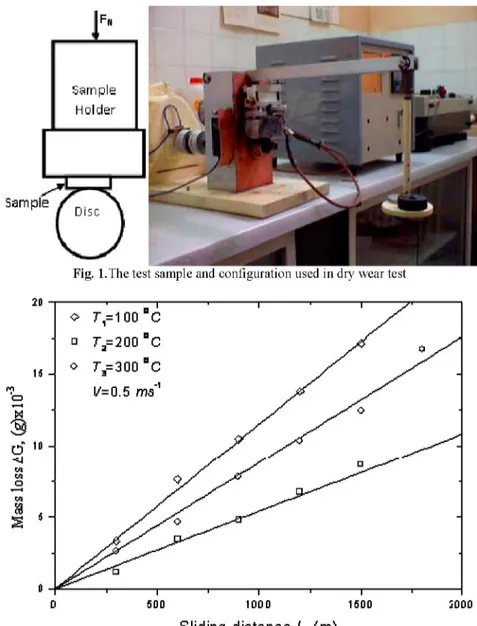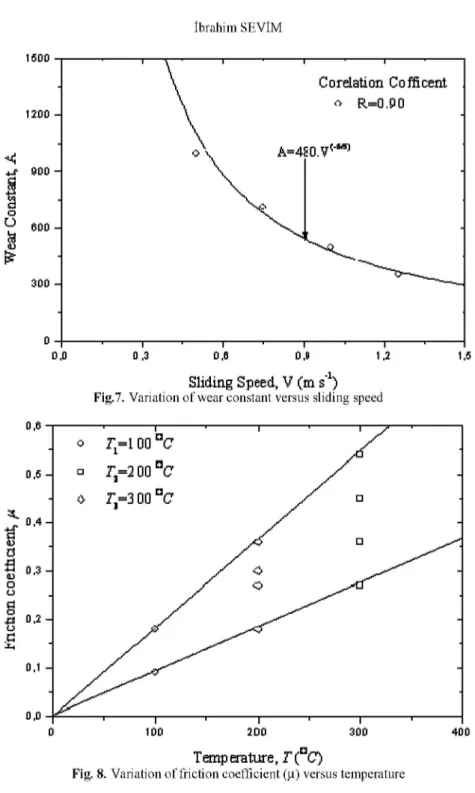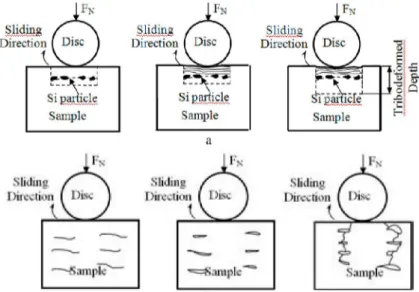3 (2), 2009, 161 - 164
©BEYKENT UNIVERSITY
Wear Behavior of Al-9Si-1Cu Alloy at Different
Speeds and Temperatures
İbrahim SEVİM
Mersin University, Engineering Faculty, Dept. of Mechanical Eng. 33343 Ciftlikkoy, Mersin, Turkey
E-mail: isevim@mersin.edu.tr
Received: 27.04.2009, Accepted: 05.11.2009
Abstract
Aluminum-Silicon alloys (Al-Si) are widely used in industry and internal combustion engines for good friction, wear, heat conduction, lightness and handling properties. The pistons, cylinder blocks of internal combustion engines and brake systems are continually operating under variable temperature and velocities. Due to this, they are exposed to wear and deformation. To prevent these effects, 9Si-1Cu alloy is widely used. In this study, the behavior of 9Si-1Cu alloy under different velocities and temperatures is investigated.
Özet
Alüminyum-Silikon (Al-Si) alaşımları, sürtünme, aşınma, ısı iletme, hafiflik ve işlenebilirlik özelliklerinin iyi olması sebebiyle içten yanmalı motorlarda ve endüstride yaygın olarak kullanılmaktadır. İçten yanmalı motorların pistonları ve silindir blokları, ayrıca fren donanımları gibi parçaları sürekli olarak değişken sıcaklıklarda ve değişken hızlarda çalışmaktadır. Bu özelliklerinden dolayı, sürekli olarak aşınmaya ve şekil değişimine maruz kalırlar. Bu amaçla 9Si-1Cu alaşımı özellikle çok yaygın olarak kullanılmaktadır.
Bu çalışmada, değişik hızlarda ve değişik sıcaklıklarda 9Si-1Cu alüminyum alaşımının aşınma davranışı incelenecektir.
1. Introduction
Al-Si alloys are very widely used for application in the internal combustion engine that require good friction and wear resistance. Al-Si alloys at the internal combustion engine is used in engine blocks, cylinder heads, intake manifolds, pistons, wheels, compressor parts, break calipers, and transmission and steering systems. The application of aluminum-silicon attempts to reduce the weight of automobiles so as to improve fuel efficiency [1-10]. Aluminum casting alloys are being continually reviewed in an attempt to replace cast iron
components and substantial changes are likely to occur in the next few years. Aluminum-Silicon cylinder blocks have been used in many production automobiles from as early as 1960. Silicon and copper have the most significant effect in increasing the wear resistance of aluminum alloys. The effect of the cooling rate during casting or subsequent heat treatment on the second-phase particle size affects the wear behavior only slightly, even though it brings about considerable improvement in mechanical properties [11-12]. The aim of this paper is to research the wear behavior of aluminum-silicon alloys at different speeds and temperatures.
2. Experimental Procedure
The material selected for the investigation was on 9Si-1Cu aluminum alloy with nominal composition is given Table 1 .The samples were in the form of
10x10x10 mm3 cubic blocks. In order to achieve a uniform contact between the
steel disc and specimen, contact surface (10x10 mm2) of each specimen was machined to form a concave surface 30 mm diameter. The curved surfaces were polished to 0.5 mm alumina to eliminate any damage, which occurred during the machining operation. All tests were carried out at ambient conditions. The micro hardness tests were carried out using Vickers indentation test at 25g load (HV0.25). The details of physical and mechanical properties listed in Table 2.
Table1. Chemical compositions of Al-9Si-1Cu (wt %)
Si Fe Cu Mn Mg Zn Ni Bal
11.88 0.42 1.090 0.01 1.03 0.02 0.96 Al
Table 2. The physical and mechanical properties of Al-9%Si-1%Cu- alloy
Properties Material
Properties
Al-9%Si-1%Cu
Vickers hardness (kg 25 g /mm2) 124+3
Density (mg/m3) 2.7
Tensile strength (MPa) at 293 K 109.6
Percent elongation 3.0
Compressive flow stress (MPa) at e=0.02 and 293 K 180.4
Wear tests were carried out under dry sliding conditions against a rotating steel disc using a block-on-disc apparatus which wear machine having a heating unit. Sample configuration is given in Fig. 1. The counterface disc having 30
mm outer and 20 mm inner diameters and thickness 13 mm was prepared AISI
52100 bearing steel. The counterface rotating steel disc was hardened to Rockwell C 63±3. The test sample was put into a sample holder after cleaning and weighing the wear couples, and they wear inserted into the wear tester. The test samples were heated to the test temperatures of 100, 200 and 300 oC.
A constant force of 55 N was applied during the tests. The speed and duration of the test were 0.5, 0.75, 1.0, 1.25 ms-1 and 600 s under the test conditions, respectively. The test blocs were capable of being indexed in two positions. Thus, two results could be obtained from each test specimen. The test blocks were static under test loads while the disc was rotated during the tests. The frictional forces were also recorded continuously during the experiments. The weight losses were calculated from the differences in the weight of the specimens measured before and after the tests to the nearest 0.1 mg using an analytical balance.
3. Results and Discussion
Mass loss due to wear versus distance is given Figs. 2-5. It is clear from the figure that mass loss varies linearly with sliding distance. Also the mass loss is dependent on the sliding velocity and temperature. Fig. 6 demonstrates that the wear rate decreases as sliding velocity increases. During wear shear stress on and under the surface is created as the disc across the sample (fig. 1). The deformation on the surface of the sample reaches the fracture level earlier with increasing slide rate. As a result of this, more mass loss occurs. As the temperature of the wear material reaches high degrees (approximately 300 oC), a wear layer on the sliding surface of the material is formed under the effect of temperature and the pressure between the disk and the surface of the material. This layer reduces the mass loss, because the layer deforms permanently under the temperature and pressure. Some theories are proposed to explain this phenomenon [13-14]. Delamination theory can be used to explain the wear properties of Al-Si alloys [15]. Delamination wear is classified as primary and secondary types. The under surface harm happens in a few phases. Brittle Si phase is the main reason for under surface harm. Under surface slide stresses are the main forces for the under surface harm, which results in primary delamination [14-15]. The slide surface harm for the secondary delamination is thought to be in several phases. The harm is a function of the temperature and the normal pressure on the sliding surface. This harm is not related to the brittle Si phase. The basic reason of this is the tribo-deformation on the sliding surface due to the applied temperature and the pressure to the sample. In result, contact fatigue occurs on the surface of the sample. This results in cracks in the precipitating silicon zones due to increasing temperature and sliding distance of the dry wearing sample. As the cracks grow, the surface harm occurs on the wear surface. If these effects are repeated constantly, the cracks grow beyond the harmed zone. This removes large wear chips from the surface. These chips causes smearing with the effect of temperature, if the temperature is high enough (approximately, half of the melting temperature Tm/2). Since these chips smear the sample, there will be no mass loss. The wear resistance of the sample can be expressed as follows;
W
-=
6 1 ( 1 )V5 T5
where W is the wear resistance of the experiment sample (m.g-1), A is a constant, V is the slide velocity of the material (m.s-1) and T is the measured temperature of the material during the slide (oC).
4. Conclusions
An investigation onto the effect of elevated temperatures on dry sliding wear and the coefficient of friction of cast Al-9 Si -1Cu alloys has yielded the followings:
• Depending on the sliding distance, the mass loss reduces with the increasing temperature. The reduction in the mass loss can be explained using the delamination theory (Fig.9).
• The wear resistance decreases exponentially with the slide rate and the temperature. The exponentials are (6/5) and (1/5) for slide rate and the temperature, respectively, as in Eq.(1).
• The friction coefficient ( • ) increases linearly with the temperature of the material (Fig.8).
Nomenclature
= Differences in the weight of the specimens measured before and after the tests (g)
DG
Wg / L = =Wear intensity (g/m)
L
W-1 =Wear resistance (m/g)
Acknowledgements
This work is supported in part by the Mersin University Grant no MUHFMM (IS) 2007-1. The author would like to thank Dr. Huseyin Canbolat of the Electrical and Electronics Eng. Dept. at Mersin University.
REFERENCES
[1] SHABEL, B.S.-GRANGER, D.A.-TRUCKER W.G.: Friction and Wear of Aluminum-Silicon Alloys, ASM 18, 1998
[2] GRUZLESKI, J.-CLOSSET, B.: The Treatment of Liquid Aluminum-Silicon Alloys, AFS, 1990
[3] DEUIS, L.-SUBRAMANIAN, C.-YELLUP J. M.: Wear, 57, 1997, p.415. [4] HUTCHINGS, I. M.: Tribology: Friction and Wear of Engineering Materials, Edward Arnold, London. 1992.
[5] GERCEKCIOGLU, E.-KARAMIS, M. B. Wear, 243 2000, p.76
[6] DWIVEDI, D. K.: Materials Science and Engineering A, 1-2, 2004, p.328 [7] LI, X. Y.-TANDON, K. N.: Wear, 1, 1999, p.640.
[8] DWIVEDI, D. K-. ARJUN, T.-THAKUR, S. P.-VAIDYA, H.,-SINGH, K.: J. of Materials Processing Technology 152, 2004, p. 323
[9] Qing, X. X,- Xiang F. T.- He S. B.- Di, Z.- Sakata, T- Mori, H.-Okabe, T.: Materials Science and Engineering A, 342, 2003, p.287
[10] ANCASTER, J. K.: Proc. Phys. Soc. B, 70, 1957, p.112
[11] ZUM GAHR, K. H.: Microstructure and Wear of Materials, Elsevier Science, 1987 [12] SEVIM, I.: Kovove Mater., 43, 2005, p. 158.
[13] ZHANG, J-ALPAS, A.: Acta Mater., 45, 1997, p.513 [14] WILSON, S.- ALPAS, A.: Wear, 212, 1997, p.41
[15] ROHATGI, P. K.-DAHOTRE, N. B.-LIU, Y.-BARR, T. L. Wear Resistance of Metals and Alloys: Proceeding of a Conference held in Conjunction with the 1988 World Materials Congress, Ed.: KINGSBURY, G. R. Chicago, ASM International 1988, p.47
Fig. 1.The test sample and configuration used in dry wear test
0 SOD 1DDD 1500 2000
Sliding d i s t a n c e L, (m)
Slidinci d i s t a n c e L. (m)
Fig. 3. For sliding speed V=0.75 m/s variation of mass loss versus sliding distance
Sliding d i s t a n c e L, (m)
Sliding d i s t a n c e L. (m)
Fig. 5. For sliding speed V=1.25 m/s variation of mass loss versus sliding distance
Temperature T, f C)
Fig.7. Variation of wear constant versus sliding speed
b
Fig. 9. Schematic representation of two mechanisms involved in sliding wear:





